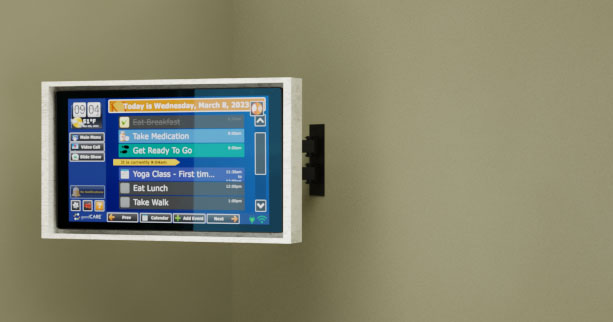Testimonial from Stacey Pierce, Director of LIVE@HOME Technologies:
LIVE@HOME Technologies understands the new frontier of in-home care through technology, using both low and high tech technology to meet the needs of our clients. We use everything from telephone check ins, Personal Emergency Response Units and Remote Telehealth & Activity of Daily Living Monitoring Systems such as GrandCare Systems. The GrandCare technology is result driven; a “proactive versus reactive care solution”. As one example, Mr. C has had many heart surgeries, Congestive Heart Failure, and Diabetes. We have worked with his doctors to set wellness parameters and goals to prevent a future “event”. This type of awareness and proactive care can mitigate hospital stays and detect potential symptoms before it becomes life-threatening. Using GrandCare technology, we have kept Mr. C in his home for two years now, saving him and his family, roughly $112,000.
In home care can be very expensive and many simply cannot afford or do not need 24 hours of hands-on care. We utilize technology, such as GrandCare Systems, to work in conjunction with professional caregiving staff. Live@Home Technologies has placed GrandCare technology in many homes, not only as a cost- effective way to stay at home, but also to assess if and when additional care might be warranted.
Live@Home Technologies has also designed programs to save money for Long Term Care Facilities as well as their residents. The average cost of Independent Living at The Oaks, a CCRC in South Carolina, is $2,000.00 per month and goes up to $3,5000.00 for Assisted Living. Live@Home Technologies implemented a new “Monitoring Independent Area of Living” program at the Oaks by using GrandCare motion, door and bed sensor technology to monitor several residents at once. This concept allows the Oaks to reduce unnecessary footsteps and save money by making fewer caregivers more efficient and effective. Each resident has seen a cost savings of $1200.00 per month, that’s almost $15,000.00 per year.
Through the setting of individual rules, we monitor activities such as wandering, being out of bed, leaving apartments in middle of night, not accessing medications, or too much motion in bathroom; all of which have been directly related to UTIs, medications not being taken properly and increased Sundowners. Using the GrandCare technology, we assess each individual’s ADLs, allowing us to be proactive and respond to any notable changes in daily life. Although, technology does not replace care giving and human touch, it can be a helpful tool to gain information on a possible event, save health care costs and give an added peace of mind, while staying at home.
We eagerly anticipate the many exciting ways we can take advantage of the advances in technology to provide top-notch in-home care that meets the demands of our caregiving staff, our residents and their family members.
-Stacey Pierce
Director of LIVE@HOME Technologies
About LIVE@HOME Technologies
The Methodist Oaks has more than 50 years of experience of mission and ministry with seniors giving care and services at our Faith Based Continuing Care Retirement Community (www.theoakssc.com). In the last few years, recognizing the need to expand our care giving to a greater community, the Board of The Oaks made the decision to offer our expertise in the integration of Care and Technology throughout South Carolina and portions of North Carolina and Georgia.
The Oaks created LIVE@HOME Technologies to offer the latest in rapidly changing technological advances to assist people in staying at home. LIVE@HOME Technologies constantly researches and test various technologies which are available and utilizes that which best suits the client’s situation. LIVE@HOME Technologies learned early on that the most critical step of helping people stay at home rather than moving to an Assisted Living or other living option is the evaluation of the needs and desires of the potential client and the family.










